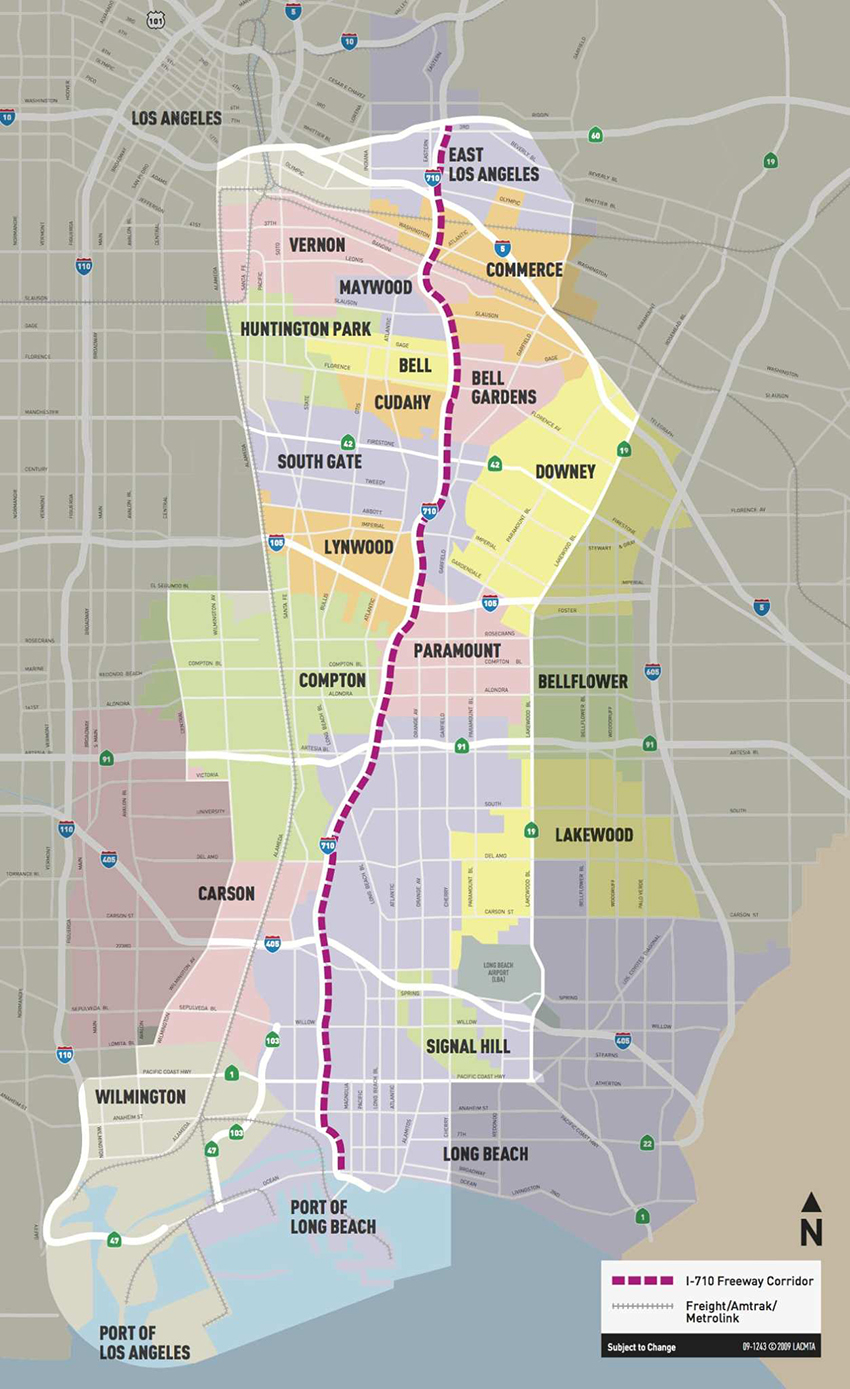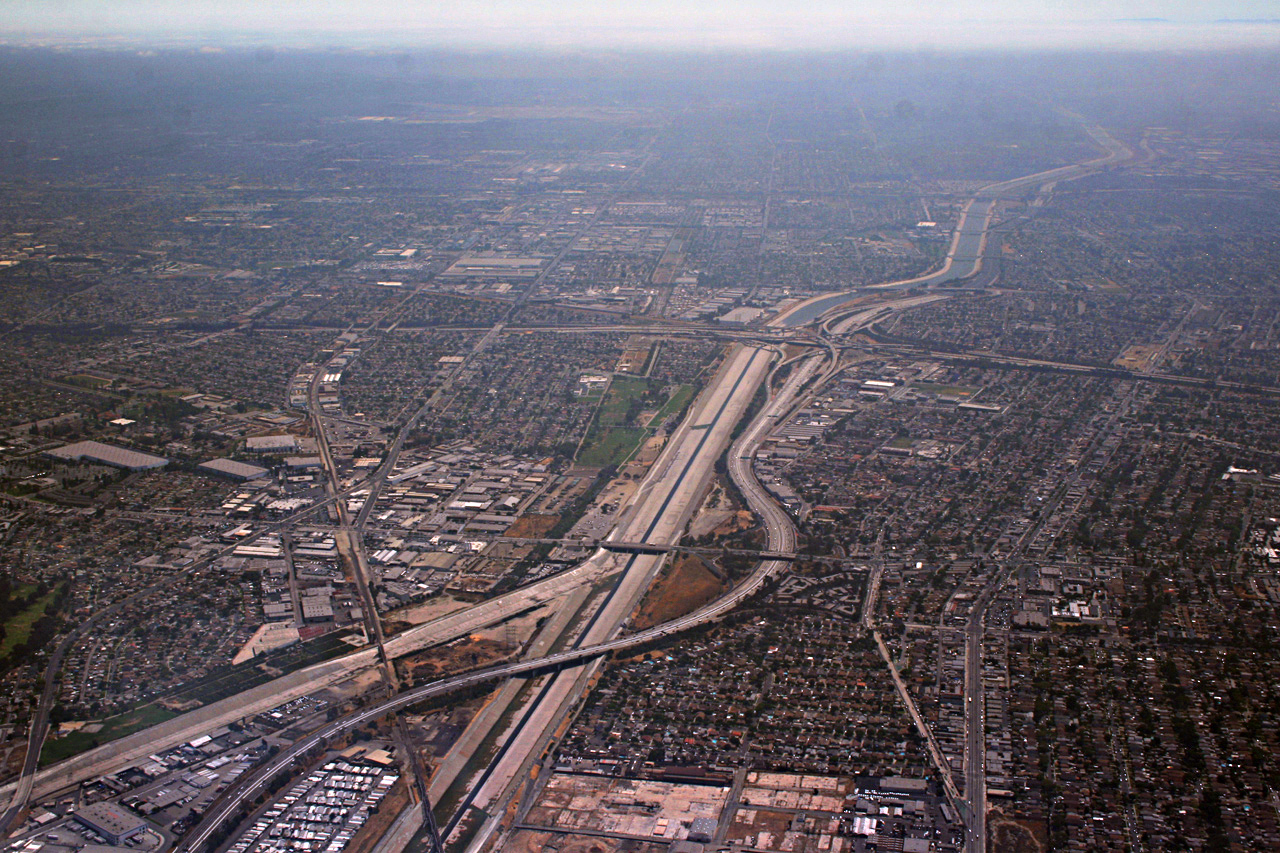By Jenny Jones
After more than 15 years of planning, transportation agencies in California had to sideline a project that would have expanded the 19 mi long, southern portion of Interstate 710 between East Los Angeles and the ports of Long Beach and Los Angeles. This is one of the busiest heavy truck and commuter traffic corridors in the nation. The move came in the spring after the U.S. Environmental Protection Agency rejected a proposed air quality review alternative to the standard review protocols established under the Clean Air Act that was put forward as part of the planned project, citing the area as having “the worst air quality in the United States.”
Due to the EPA’s decision, the agencies are reconsidering their own concerns about air quality, equity, mobility, and sustainability. As a result, the Los Angeles County Metropolitan Transportation Authority, known as LA Metro, assigned a task force to reassess how to invest in the I-710 corridor in a multimodal manner to address local and regional concerns. As part of this process, the group will also consider project alternatives that will meet stakeholder expectations and the air quality standards that the EPA outlined in a letter earlier this year. Stakeholder expectations include limiting negative environmental and social impacts on the surrounding communities, say Brian Haas, the communications manager for LA Metro.
LA Metro is leading the I-710 Corridor Project in partnership with the California Department of Transportation, known as Caltrans, and other agencies. In the first half of 2022, the group expects the task force to report recommended steps forward for the corridor.
LA Metro and Caltrans worked with regulatory agencies, including the EPA, and community stakeholders for many years on this project and knew its air quality conformity challenges. However, in the end, air quality proved to be an “insurmountable challenge for the project,” Haas explains.
‘Diesel death zone’
LA Metro and its partners began studying I-710 between East Los Angeles and the two ports to assess infrastructure improvement needs in 2005. According to the 2016 supplemental draft environmental impact statement, high levels of diesel particulate emissions, traffic congestion, high truck volumes, high accident rates, and outdated design features were causing elevated health risks along the corridor, which was originally designed and built in the 1950s and 1960s. Today, the freeway carries more than 200,000 vehicles a day as some 34% of all U.S. containerized cargo — imports and exports — flow through the two ports, according to LA Metro’s 2021 LA County Goods Movement Strategic Plan.

Map of suspended expansion project (courtesy of LA Metro)
However, the report notes, “This freeway is known as the ‘diesel death zone’” because “while ‘goods movement’ is a major economic driver for our region, it comes at a high cost for the many communities and residents along the 19-mile freeway. For many years, children and adults alike have suffered from serious health issues as a result of the pollution emitted by the trucks … and neighborhoods have been severely impacted by congestion and traffic.”
According to the EPA’s 2009 toxic release inventory for the I-710 corridor, approximately 2,000 premature deaths were associated with diesel emissions in the South Coast Air Basin, which includes Orange County and the urban areas of Los Angeles, Riverside, and San Bernardino counties.
Proposed air quality alternative
LA Metro and its partners initially conceived multiple concepts aimed at addressing the health, safety, and congestion issues along the I-710 corridor. The concepts also took into consideration projected future traffic volume increases. After the agencies conducted an environmental review, gathered public input, reexamined the traffic conditions, and refined the design alternatives, the LA Metro board of directors approved the project plan in 2018.
Among other changes, the approved $6 billion Alternative 5C plan, as it was known, called for adding one mixed-flow lane in each direction, incorporating new truck bypass lanes at the I-710/I-405 interchange, and reconfiguring the interchanges along the corridor. Knowing that air quality conformity would be difficult to achieve, given the area’s already extreme particulate levels and proposed roadway capacity increases, agency officials included in the plan an alternative to the EPA’s traditional particulate matter hot-spot analysis. Known as the I-710 Clean Truck Program, the alternative called for putting 4,000 zero- or low-nitrogen-oxide-emitting trucks on the interstate to offset the diesel emissions of the remaining vehicles.
Robert Garcia, the Long Beach mayor and a former member of the LA Metro board of directors, praised the plan in a 2018 press release. “The 710 is the gateway to America’s ports, and we need to make the highway safer and modernize the on and off ramps,” he said. “The actions by the board will help us protect our communities and will provide hundreds of millions of dollars for significant improvements to neighborhoods along the 710. This project will clean the air and move us toward a zero-emissions future.”
‘Environmental racism’
Not everyone was happy with the plan, however. East Yard Communities for Environmental Justice, a regional advocacy group that includes residents who live along the I-710 corridor, and other similar organizations opposed the project. They argued against expanding the roadway’s capacity and called for a mandatory zero-emissions policy to reduce air pollution along the corridor.

In addition to the air quality concerns, the groups opposed the project because it would cost people their homes. LA Metro and Caltrans officials estimated that plans to widen the freeway would displace 436 people in 109 homes and 158 businesses in the predominantly Black and Latino communities along the freeway. With these issues in mind, Laura Cortez, executive director of East Yard, called the project a “clear depiction” of “environmental racism,” according to a Los Angeles Times report.
History indicates that such concerns are legitimate. Research shows that transportation agencies nationwide have a record of disrupting minority communities. In the mid-20th century, California officials used federal funding to intentionally route I-710 and other thoroughfares through minority neighborhoods, disconnecting them from economic opportunities and subjecting them to a host of other negative consequences, according to Caltrans’ Racial Equity Statement. (Read more about the history and current efforts pertaining to equity and infrastructure in the United States in the ongoing Civil Engineering magazine and Civil Engineering Source series on the topic.)
In response to questions from Civil Engineering magazine, Haas said that LA Metro was sensitive to environmental and social justice issues. “Metro’s intent is not to exacerbate existing inequities or environmental hazards or create new ones with our highway projects,” he says. “On the contrary, Metro is looking to lead with equity as we envision any highway improvements. That means working with communities that rely on and are most impacted by highways to understand their needs and the disparities they face, identify strategies for improvement, and assess and adjust for inequitable impacts.”
EPA decision
While community opposition has caused some hiccups in the I-710 Corridor Project through the years, it was the EPA’s decision to uphold its standard air quality analysis requirements that ultimately upended the project in the spring. “EPA is very supportive of using zero-emissions truck technology on the I-710 freight corridor, but it is critical that public agencies develop a program that meets all of the regulatory requirements so that emissions will not increase and negatively impact public health in the future,” the EPA’s technical response states.
Considering the air quality concerns and environmental justice issues surrounding the project, Caltrans Director Toks Omishakin was reportedly among the first California transportation officials to publicly withdraw support for the I-710 proposal. “I don’t see how we can move forward with this project in its current format,” Omishakin said in May 2021, according to a Los Angeles Times article.
A state law passed in 2019 requires Caltrans to outline steps in the California Transportation Plan to “achieve maximum feasible emissions reductions in order to attain a statewide reduction of greenhouse gas emissions of 40% below 1990 levels by the end of 2030.” The law also notes that environmental justice must be considered for the movement of people and freight.
Part of the solution
It’s not just transportation agencies that must commit to environmental and social equity goals. Civil engineering firms also have a responsibility to advance these efforts, said Clint Isa, P.E., M.ASCE, a principal engineer at Diaz Yourman & Associates in Santa Ana, California, and the president of the ASCE Orange County Branch in an interview with Civil Engineering.
“One of the canons of ASCE is to protect the health, safety, and the welfare of the public,” Isa says. “If you’re contributing to the design and construction of a project that is going to displace people and/or introduce (or) exacerbate health and safety issues, we have an obligation as civil engineers to make sure that we have looked at possible avenues to avoid doing so before we actually build a project. As stewards for the public’s health, safety, and welfare, we should expect to be doing that because it’s the responsible thing to do.”
One way engineering and construction firms can determine whether projects meet increasingly rigorous environmental and social equity standards is through certification by the Envision Rating System, Isa says. Working with organizational partners, ASCE created the tool, which rates the sustainability of various civil projects in all sectors — from transportation to waste — using 60 criteria.
“Encouraging projects to be certified through the Envision Rating System puts a premium on making sure that the agency or entity that is procuring and delivering the project is getting out and engaging with members of the public who are going to be impacted by the project,” Isa says. “It’s part of how we, as a civil engineering community, are trying to be mindful of these issues when projects are being delivered.
“As the I-710 project shows, these issues can have real impacts on projects and real consequences for the public,” Isa notes.



